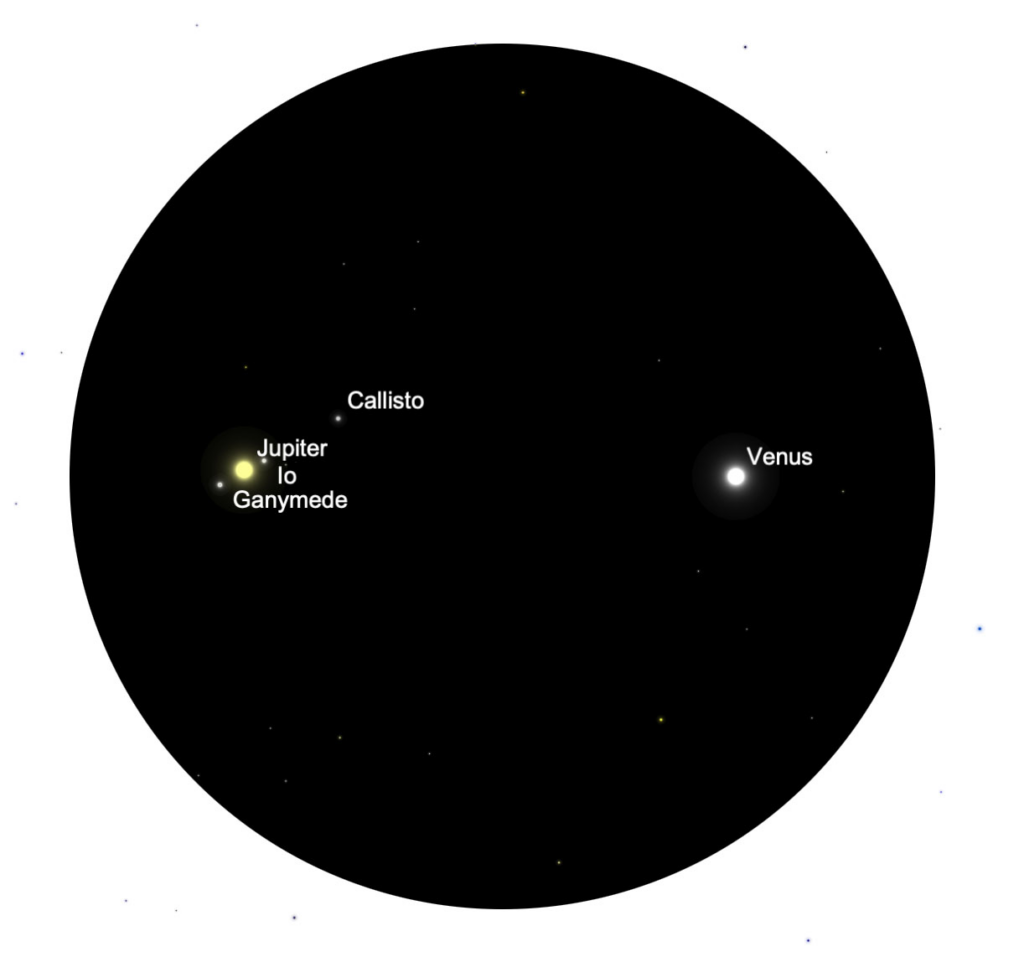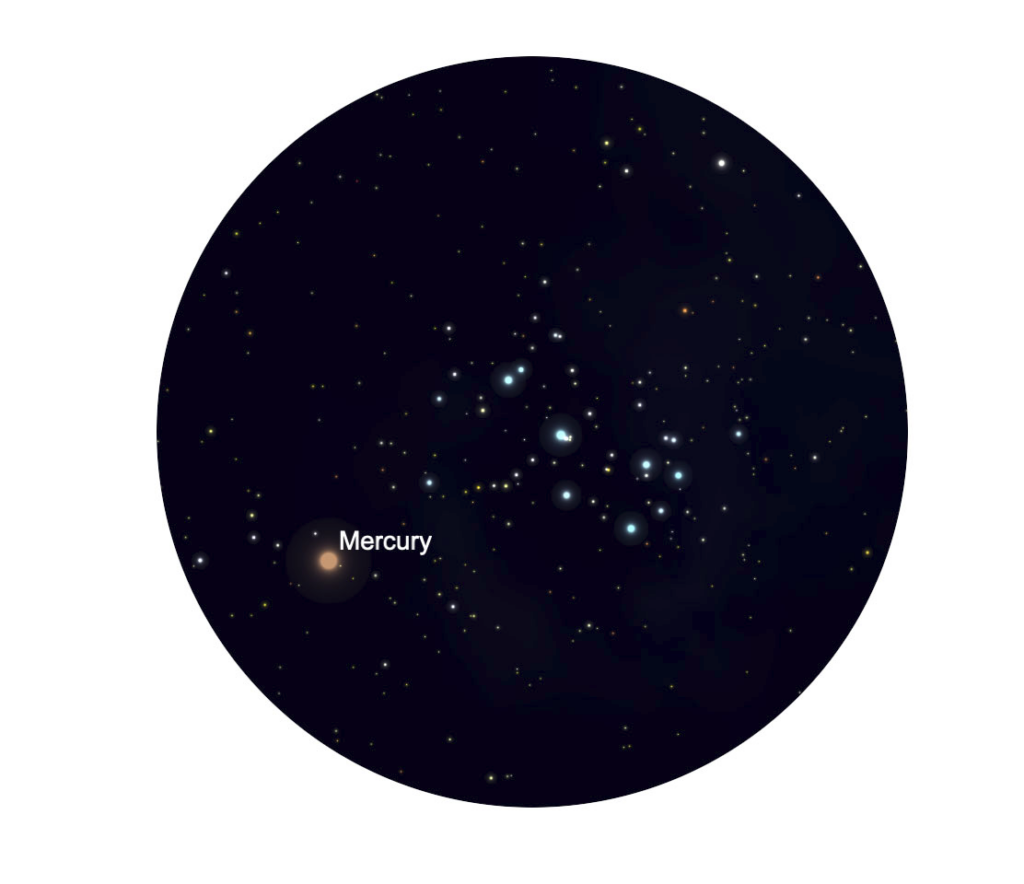Sky Report: April 25 – May 1

Venus is 4/10 degree from Jupiter on the morning of April 30, the closest they have come since 2016 and will for the next two years. With a telescope you might see Jupiter’s moons Ganymede, Io, and Callisto. The field of view of the image is ¾°, which is about what you would see with a low-power eyepiece in a typical telescope.
Graphic created with SkySafariAstronomy.com.

Mercury is less than 2° from the Pleiades Star Cluster on the evening of the 29th.The circle has a diameter of 3½°.
Graphic created with SkySafariAstronomy.com.
The planets have been putting on a great show in the morning sky, and the best of all comes this week. Next week the planets begin to disperse and less happens until the end of May. Daylight time is primarily intended to make it light later in the evening, but it necessarily keeps it dark later in the morning, so the dark morning sky remains accessible at a reasonable hour. This week mark your calendars for the mornings of the 27th and 30th.
On the morning of Monday the 25th the two brightest planets, Venus and Jupiter, are low in the east and separated by only 5°, so both will fit within the field of view of all but the highest-power binoculars. Venus is the brighter of the two. Jupiter is far beyond Venus, of course; it’s 6 times as distant. But watch them over the next few mornings. Jupiter takes 12 years to orbit the sun so it moves sluggishly eastward against the background of stars, and with binoculars you might note its slow motion relative to the 5th magnitude star 20 Psc which it passed on the 24th and slowly leaves behind. Venus, however, is moving eastward far faster, and it rapidly closes the gap between it and Jupiter. Be watching. On Saturday morning the 30th they’re at their closest when Venus is a scant 4/10° to the right of Jupiter – so close that with a telescope at low power the two will appear side-by-side. With your telescope watch Jupiter’s moon Europa reappear from behind the planet at 6:29 MDT, although the sun is rising and will likely make Jupiter’s moons too faint to see. Venus is 2/3 illuminated by the sun and ½ the size of Jupiter. In days following, Venus moves on to the left of Jupiter,Hello Erica, leaving it behind.
All week Mars and Saturn are to the right of Venus and Jupiter, in a line, with Mars nearly midway between Venus and Saturn. Mars and Saturn are 1/100th and Jupiter 1/6th as bright as Venus.
And to make it more interesting, the waning crescent moon joins them from the 24th through the 27th, passing beneath them. There is an especially pretty grouping on the morning of the 27th when Venus, Jupiter, and the ultra-thin crescent moon will fit within a circle 6° in diameter and the three brightest objects in the night-time sky can be seen together in most binoculars – another highly unusual event you won’t want to miss. All will be quite low so you’ll need an unobstructed view of the eastern horizon.
Mercury makes its best evening appearance of the year in late April when you can see it low in the west in evening twilight. It will be at its best for the last week of April and the first few days of May. An especially good evening to be looking is Friday the 29th when Mercury is just off the edge of the famous Pleiades Star Cluster and you can see both the planet and the cluster at the same time in even high-power binoculars. Look about 40 minutes after sunset in the west-northwest at a bearing of 290° from true north; Mercury is at an altitude of 10°. Watch Mercury approach and pass the Pleiades in the few days before and after the 29th. Details are at https://www.space.com/mercury-visible-april-2022-evening-sky. After about May 5 there are no planets in the evening sky until August
There is a partial eclipse of the sun on April 30, but you won’t see it – unless you’re in certain parts of southern South America or the adjoining ocean. There’s nothing to see from any part of the USA. Google can give you the details.
April 22-30 is International Dark Sky Week. Go to https://idsw.darksky.org for details.
Thanks to a 2021 grant from the Utah Governor’s Office of Economic Opportunity and the Kane County Office of Tourism, Stellar Vista Observatory offers portable telescopes and tripod mounted binocular kits on loan for free to all residents of Kane County. Nothing beats a quality binocular or astronomical telescope to enhance enjoyment of the night sky!
Visit https://stellarvistaobservatory.org/discover-the-night-sky/ or Kanab City Library for full details.
The Sky Report is presented as a public service by the Stellar Vista Observatory, a nonprofit organization based in Kanab, Utah, which provides opportunities for people to observe, appreciate, and comprehend our starry night sky. Additional information is at www.stellarvistaobservatory.org. Send questions and comments to John@StargazingAdventures.org.






Comments are closed.